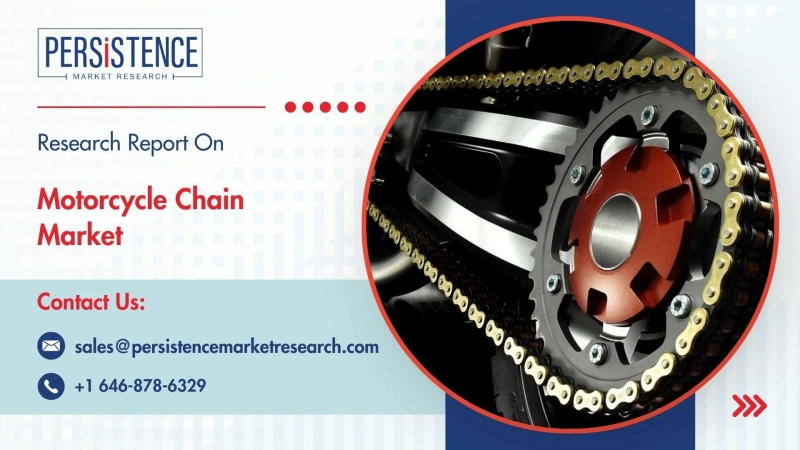The motorcycle industry is undergoing a dynamic evolution fueled by technological advancements and the demand for higher performance and durability. Among the crucial components that have seen significant development is the motorcycle chain—a critical element that transfers power from the engine to the rear wheel. While it might appear to be a simple mechanical part, the motorcycle chain has become a focal point for innovation, driven by the increasing expectations of both manufacturers and consumers.
According to the Persistence Market Research report, the global motorcycle chain market is poised for substantial growth over the coming years. The market size, which is estimated to reach US$ 2,732.4 million by 2025, is expected to surge to US$ 4,054.5 million by 2032, reflecting a compound annual growth rate (CAGR) of 5.8% from 2025 to 2032. This growth is underpinned by continuous improvements in chain technology, materials science, and product design, all aiming to meet the changing demands of the global motorcycle industry.
Material Innovation: Stronger, Lighter, and More Durable
One of the primary areas where innovation is shaping the motorcycle chain market is in material development. Traditional chains made from standard carbon steel are increasingly being replaced or enhanced by high-strength alloys, nickel-plated, stainless steel, and even titanium-based materials. These newer materials offer improved corrosion resistance, tensile strength, and wear resistance, making them ideal for both everyday use and high-performance motorcycles.
For instance, nickel and zinc coatings are now commonly used to protect chains from rust and extend their lifespan, especially in humid or coastal environments. The use of lightweight alloys also contributes to better fuel efficiency and overall motorcycle performance by reducing the rotational mass. These material enhancements are essential in competitive racing environments where even minor improvements in weight and durability can provide a significant edge.
Sealed Chains: O-Ring and X-Ring Advancements
Perhaps one of the most impactful innovations in motorcycle chain technology is the widespread adoption and evolution of sealed chains, particularly O-ring and X-ring chains. Unlike standard chains, sealed chains are designed with rubber rings between the inner and outer links, which help retain lubrication and keep out dirt, moisture, and debris. This results in lower maintenance requirements and a significantly longer operational life.
X-ring chains are considered a step up from traditional O-ring designs. Their unique shape reduces friction even further while maintaining an excellent seal for internal lubrication. These chains are now widely used in sportbikes, adventure motorcycles, and even commuter bikes, thanks to their blend of performance and longevity. As these technologies become more affordable, they are quickly replacing older chain types across various market segments.
Self-Lubricating and Maintenance-Free Technologies
A major concern for many motorcycle owners is chain maintenance, which typically involves regular cleaning and lubrication. In response, manufacturers have begun developing self-lubricating chains and maintenance-free chain systems that minimize the effort required to keep the chain in optimal condition.
Self-lubricating chains incorporate built-in lubrication systems that automatically dispense small amounts of lubricant as the chain operates. Some models feature Teflon-infused bushings or polymer coatings that reduce the need for external lubrication entirely. These innovations not only reduce the cost and effort of maintenance but also contribute to smoother performance and longer service intervals, which is particularly attractive for long-distance riders and fleet operators.
Integration with Smart Motorcycle Systems
As motorcycles become smarter and more integrated with digital technology, chains too are evolving to align with this trend. Advanced motorcycles now feature chain wear sensors that alert riders when the chain needs adjustment or replacement. This form of predictive maintenance helps prevent unexpected failures and improves rider safety.
In addition, high-end motorcycles equipped with connected diagnostic systems can monitor chain tension, temperature, and alignment in real-time, offering immediate feedback to the rider or sending alerts to mobile apps. These technologies not only enhance convenience but also ensure that motorcycles operate at peak efficiency.
Customization and Application-Specific Chains
Modern consumers increasingly demand customization and performance tuning, and the motorcycle chain market is responding with application-specific products. Chains are now being engineered to match different riding styles, engine capacities, and terrain conditions. For example, off-road chains are designed with more aggressive link geometries and special coatings to handle mud and sand, while racing chains prioritize weight reduction and high-speed efficiency.
This level of customization is especially valuable in motorsports and adventure riding, where standard chains may not offer the performance or durability required. Manufacturers are also offering color-customized chains, allowing riders to personalize their motorcycles while still benefiting from advanced chain technology.
Environmental and Sustainability Considerations
With growing global awareness of environmental issues, the motorcycle chain industry is also beginning to embrace sustainable manufacturing practices. Chain producers are exploring eco-friendly coatings, recyclable materials, and low-impact production techniques to reduce their environmental footprint. Some companies are now using water-based lubricants or biodegradable oils in the manufacturing and after-sales servicing of chains, appealing to eco-conscious consumers and aligning with regulatory shifts towards greener practices.
Additionally, as electric motorcycles become more mainstream, chain manufacturers are developing solutions specifically designed for low-noise, high-efficiency operation. Electric motorcycles typically have smoother torque curves, which affect how stress is applied to the chain. This is leading to innovations in chain design that optimize energy transmission while minimizing maintenance requirements.
Competitive Landscape and Market Expansion
The global motorcycle chain market is witnessing heightened competition as both established brands and new entrants vie for market share. Leading manufacturers are investing in research and development, strategic partnerships, and global expansion to tap into growing markets in Asia-Pacific, Latin America, and Africa, where motorcycle ownership is rising rapidly.
Emerging economies, particularly India, Indonesia, Brazil, and Vietnam, are expected to play a vital role in market expansion due to their large populations of two-wheeler users. The need for affordable, durable, and low-maintenance chains in these regions is driving innovation at both the premium and budget ends of the product spectrum.
Conclusion: Innovation Driving Growth
The motorcycle chain market, long considered a mature segment, is being revitalized by a wave of technological advancements and product innovations. From high-strength materials and sealed chain designs to self-lubricating systems and smart integration, today’s motorcycle chains are more efficient, durable, and user-friendly than ever before.
According to Persistence Market Research, the market is set to grow from US$ 2,732.4 million in 2025 to US$ 4,054.5 million by 2032, driven by a steady CAGR of 5.8%. This growth trajectory underscores the critical role that innovation plays in meeting the evolving needs of a global, performance-focused, and increasingly tech-savvy customer base.
As motorcycle technology continues to advance, so too will the components that support it. Motorcycle chains, though humble in appearance, will remain a key player in vehicle performance and rider satisfaction, with innovation at the core of their ongoing evolution.


